THE MACROFUNGI OF BRITISH COLUMBIA
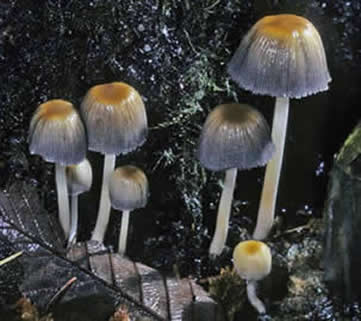
Mica-cap (Coprinellus micaceus). Photo by Michael Beug.
by
Michael Beug
Professor Emeritus, The Evergreen State College
Visit our fungi atlas pages
View an alphabetical working list of all fungi in BC by Kent Brothers
(the same list in taxonomic order)
Fungi are so diverse and so fascinating that their discussion deserves an entire book. So if what you are about to learn in this introduction piques your interest, seek out a book like The Fifth Kingdom by Bryce Kendrick or The Fungi by M. J. Carlisle, S. C. Watkinson and G. W. Gooday to learn more. You will discover that fungi rival plants in species diversity and occupy many more ecological roles than any other group of organisms. You will learn how some fungi cause plant disease, others cause human infections while others like yeast make our bread rise or our alcoholic beverages ferment and still others are the sources of our most important antibiotics and the drugs that help prevent tissue rejection thus making transplants possible. Yet none of these fungi are the subject of E-flora because in E-Flora we get a chance to see and learn about macrofungi, the larger fungi that we know as mushrooms. There are over 1600 species of macrofungi recorded from British Columbia. There are hundreds of additional named species found in the Pacific Northwest but not yet recorded from B.C. that are likely to turn up when people start looking for them. In addition, there are numerous species, probably one to three thousand or more, present in B. C. but not yet named or still waiting to catch the eye of someone who will recognize the mushroom as new to science. All of this brings the probable number of mushroom species in British Columbia to somewhere on the order of 5,000 species, possibly even 10,000 species.
In talking about mushrooms, we tend to use plant terms and mycologists are generally housed in departments of botany. Indeed, fungi were long considered part of the plant kingdom and are intimately tied to plants, but biologically they are really much more like animals on a cellular level. As organisms, fungi are incredibly different from both plants and animals. The mushroom plant itself is composed of masses of threads that are each so small in diameter as to be microscopic but are visible in quantity. These tiny threads make up the mushroom mycelium. What we refer to as the mushroom is the reproductive structure that carries microscopic spores, which will produce new mycelium when they alight on a suitable surface. Most mycelium is white and you generally cannot tell one kind of mushroom mycelium from another by direct observation, only by DNA analysis. An exception is the bright yellow Piloderma mycelium (Figure 1), which does not produce mushrooms.

Figure 1: Piloderma mycelium. Photo by Michael Beug.
A striking difference between fungi and both plants and animals is that while plants and animals have two sexes, fungi have the equivalent of many sexes, up to a hundred or more, known as mating types. When two hyphal threads of compatible mating types touch, they fuse and grow together. Fused hyphae, known as dikaryotic hyphae, are what produce the mushroom fruiting bodies Monokaryotic hyphae can produce asexual spores, but not mushroom fruiting bodies. It is the fruiting body or sporocarp that we think of as the mushroom. And it is generally only when a mushroom plant reproduces that we know of its presence in an ecosystem. While some fungi produce mushrooms nearly every year, others produce mushrooms only infrequently, going decades without revealing their presence. Furthermore since many mushroom sporocarps only last for a few hours or a few days, discovering that they are there is much more challenging than finding a plant or an animal – thus range maps for mushroom distributions are very difficult to produce and invariably highly incomplete.
The mushrooms fall into two major groups – the Ascomycota, commonly known as Ascomycetes or Ascos and the Basidiomycota, commonly known Basidiomycetes or Basidios. With both Basidios and Ascos, the color of the spores in mass plus the size and shape of spores, as studied under a microscope, are useful features in identifying mushrooms. The difference between the two major groups has to do with how the spores are produced. In Ascomycetes, the spores are produced inside of round or elongated sacs, called asci. While there are nearly 30,000 species of Ascomycetes in the world, nearly half of all Ascomycetes form Lichens, which are dealt with elsewhere on this website. The number of Ascomycetes that form large enough fleshy mushrooms to attract mushroom hunters is probably 1,000 or so, most of which appear in the spring and early summer. The Basidiomycetes produce their spores on the outside of club-shaped structures called basidia. Excluding the rusts and smuts and other small Basidios, there are several thousand Basidiomycete mushrooms that can be found in the Pacific Northwest.
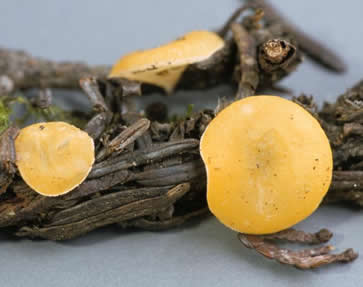
Figure 2: Pithya vulgaris. Photo by Michael Beug.
Among the Ascos, there are mushrooms with a range of environmental roles. Pithya vulgaris (Figure 2) decomposes twigs. Mushrooms that decompose dead organic matter are known as saprophytes. Morels can either be saprophytes or form mycorrhizal associations with trees depending on the environmental conditions. Caloscypha fulgens (Figure 3) is a seed parasite that parasitizes the seeds of the Douglas fir. Parasitism is not at all uncommon among the Ascomycetes. Claviceps purpurea parasitizes wild grass seed and rye grain. Consuming the dense grain-like black mass of tissue called Ergot can produce gangrene that can lead to loss of limbs and madness. Ergot itself is a structure called a sclerotium – a dense mass of fungal tissue that can over-winter and then produce spores and spread the following season when conditions are right. Claviceps purpurea contains lysergic acid and over 50 years ago Albert Hoffman was investigating possible drugs to stem bleeding at childbirth when he accidentally ingested a derivative he had made, lysergic acid diethylamide hydrochloride, now known as LSD. Some Cordyceps species (like Cordyceps militaris parasitize insects. A number of species in the genus Hypomyces specialize in parasitizing other mushrooms. Two of the most common Hypomyces species are Hypomyces chrysospermus, which turns species of Boletus into a colorful but putrid stinking mass and Hypomyces lactiflorum (Figure 8) which turns members of the Russula brevipes complex from tasteless uninteresting mushrooms into striking looking good edibles.
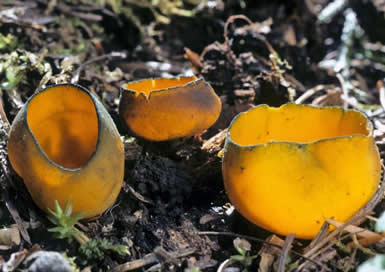
Figure 3: Snowbank Orange
Peel Fungus (Caloscypha fulgens).
Photo by Michael Beug.
Some Ascomycetes, notably the Truffles, form a mycorrhizal symbiosis with trees. There are several types of mycorrhizae that can form in nature, but the kind that you find with Truffles is the most common one that you find with trees in forest ecosystems and is known as an ectomycorrhiza – where the roots are covered by a fungal sheath and look swollen and distorted. The association is generally of mutual benefit to both partners – with the tree gaining water and minerals from the fungal association and the fungus gaining complex carbohydrates. Not many Ascomycetes form mycorrhizal associations with trees but the association between Truffles and trees is well established. In the case of the French Black Truffle, the association is exclusively with oak trees. While unripe truffles have little taste and are not of gastronomic interest, ripe truffles produce a strong odor that some find highly desirable, even rapturous. An important odor component of French Black Truffles and many other European truffles is androstenol, a sex pheromone of boar saliva. Thus female pigs make enthusiastic truffle hunters, though it is difficult to keep the sows from eating the truffles.
Dogs can be trained to find truffles and make much better truffle finders, though it is important to keep the dog from urinating on the truffles, probably because the sex pheromone tends to make male dogs want to mark their territory. The Oregon White Truffles which can be found in parts of British Columbia also have a strong odor when mature, though the odor is a mix of garlic, spice, cheese and other indescribable components. There are at least four species of Oregon White Truffles and the best place to find gourmet edible Oregon White Truffles is in Christmas tree plantations – the truffles grow in association with Douglas fir ranging in age from about 5 to 60 years old and depending on the species can fruit from October to June. The Oregon Black Truffle, Leucangium carthusianum (Figure 4), has a strong pungent fruity odor when mature, often like pineapple. The Oregon Black Truffle can be found with Douglas fir in coastal areas but can also be found in urban areas where people often think that they have found a lump of coal while gardening. It fruits from September to February.

Figure 4: Oregon Black Truffle (Leucangium carthusianum).
Photo by Michael Beug.
While all truffles form ectomycorrhizal associations with tree species, not all truffles are Ascomycetes. Many truffles are Basidiomycetes (sometimes called false truffles), like Alpova diphloeus which is associated with the roots of alder trees and is in the bolete family. Truncocolumella citrina is a Douglas fir associate that is closely related to Suillus. When mature enough to be almost butter-like, it can be spread raw on toast and is quite tasty at that stage. Ascomycete truffles and Basidiomycete truffles are important food for small mammals in the forest like the red-backed vole and flying squirrels. In fact during certain seasons, mushrooms provide 100% of the diet for these two mammals. The truffles, or hypogeous fungi, in turn depend on the mammals for spore dispersal, since they grow underground. The odor, which attracts the small mammals, is only produced when the spores are mature and ready to be dispersed. There is also something very special for seedling trees. The fecal pellets produced by the small mammals are both a concentrated source of fertilizer and a source of mycorrhizal partners via the spores which survive the digestive tract and are concentrated in the droppings, giving young seedlings a chance to get off to a fast start in life.
There are literally thousands of species of Basidiomycetes that form large fleshy fungi above ground and these are the mushrooms that you will notice most often in fields and woods. Cantharellus species can be very abundant in the forests starting in August and September. Cantharellus formosus (Figure 5) is more abundant in about 60 year-old second growth forests while Cantharellus subalbidus is more prevalent in old-growth conifer forests. Chanterelles are choice edible species that are produced by the ton in our Northwest forests and are ectomycorrhizal with conifers in our area.

Figure 5: Pacific Golden Chantrelle (Cantharellus formosus).
Photo by Michael Beug.
Now for the toadstools. Actually, originally, the word was TODE stool, which meant death mushroom, and it had nothing to do with toads. The genus Amanita contains some of the best known gilled mushrooms, aside from the button mushrooms you buy at the store. Probably the most widely illustrated and most famous gilled mushroom of all is the gorgeous, but poisonous, Amanita muscaria. All Amanita species appear to form mycorrhizal associations with either hardwoods or conifers.
Have you noticed that all of the Basidiomycetes I have mentioned so far are ectomycorrhizal? We will soon see Basidiomycetes in other roles, but ponder for a moment the critical importance of mycorrhizal relationships for plants. As mentioned earlier, we now realize that without fungal partners, plants would never have been able to move from the seas to populate the land, thus this plant/fungal relationship goes back to the very beginning of land plants, to a time before conifers and flowering plants evolved.
I had long thought that mycorrhizal relationships once established were long-lasting. I knew that some species were pioneer species, like members of the genus Laccaria, which are found in recently disturbed areas and young forest stands but are rare in mature forests. Thus trees were known to associate with one set of fungi when young and then with changing fungi as they age. In a very recent talk I learned that at least in very dry Ponderosa pine stands, the trees can change mycorrhizal partners several times per year. This work was done by taking soil cores and extracting DNA from the fungi associated with the root tips – in those dry study plots, mushrooms rarely were evident above ground. Even when mushrooms are abundant above ground, there is little or no correlation with the abundance of each species as evidenced by colonized root tips below ground.

Figure 6: Honey Mushroom (Armillaria solidipes).
Photo by Michael Beug.
Meet Armillaria solidipes (Figure 6), known to many as Armillaria ostoyae and once thought to be the same as the Eastern North American species Armillaria mellea. Armillaria solidipes found in the Ochoco Mountains of Oregon is now considered to be the largest known organism on earth and it is as old as the forest itself and as large as the entire forest. When the DNA of British Columbia Armillaria solidipes is studied, it is possible that an even larger example may be discovered. Most people do not realize that the mycelium of some mushroom species can persist for 1,000 years or more, while mushrooms that grow on dung may persist for days or less.
There are plants that can elbow their way into an ectomycorrhizal relationship between a mushroom and it tree host. Allotropa virgatum, Candystick (Figure 7), exclusively parasitizes the mycelium of Tricholoma magnivelare, White Matsutake. Since Matsutake is a highly prized edible mushroom, I keep track of locations of Candystick so that I can return in September and October and often find Matsutake. Monotropa uniflora, “Indian Pipe”, is another ectomycorrhizal cheater. Indian pipe exclusively parasitizes the mycelium of Russula and Lactarius species. Pterospora andromedea, “Pine drops”, parasitizes a few Rhizopogon species. These plants that lack chlorophyll were long thought to be saprotrophs, but it turns out that no plant is capable of breaking down organic matter. These plants are now referred to as Myco-heterotrophs. Orchids are obligate myco-heterotrophs in their seedling stage, though they develop the ability to photosynthesize and live independently of fungi later in their life cycle.
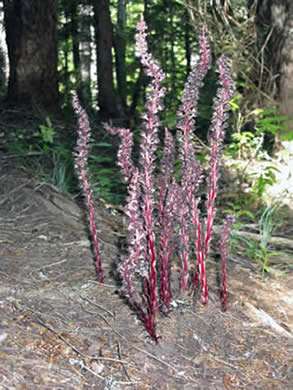
Figure 7: Candystick (Allotropa virgatum).
Photo by Michael Beug
Without the ability of mushrooms to decompose wood, leaves, grass and dung, the earth would soon be unlivable with nutrients all tied up in dead organic matter and the surface of the ground piled deep in organic remains. Many of the decomposers are highly specific in their activity. Daedalea quercina only decomposes stumps and large branches of oak trees. Marasmius salalis only decomposes certain leaves. Psilocybe inquilina specializes in breaking down the stems of grasses. Stropharia semiglobata breaks down cow and horse dung.
Most of the wood decay fungi, like Ganoderma oregonense are what is known as white-rot fungi. These fungi simultaneously decompose lignin, cellulose and hemicellulose leaving the rotten wood white and stringy. In the early stages of the wood decay there are black lines in the wood that demarcate advance of the fungal mycelium and this gives the wood a look known as spalted that is valuable in fine wood-working. Pleurotus ostreatus employs an interesting technique to get nitrogen, which is deficient in wood. Pleurotus ostreatus eats nematodes. The mushroom exudes a metabolite which stuns the nematode and then the mycelium penetrates and consumes the nematode. This probably explains why nematodes are not a problem when cultivating this delicious edible mushroom, even though nematodes can be a serious problem when cultivating the common button mushroom. Ganoderma oregonense, though a tough, inedible polypore, can be used to make a tea that supposedly has immune stimulating properties. Some white rot fungi are being investigated for mycoremediation since their powerful enzymes are capable of breaking down toxic pollutants as well as cellulose and lignin.

Figure 8: Oyster Mushroom (Pleurotus ostreatus).
Photo by Michael Beug.
The very common Fomitopsis pinicola causes a brown cubical rot of conifer wood. The brown rot fungi all have enzymes that break down the cellulose and hemicelluloses, but are unable to break down lignin.
Marasmius oreades is the fruiting body of a saprophyte that can live for 1,000 years if conditions are right, so long-life in a mushroom is not restricted to some ectomycorrhizal species. Marasmius oreades is known as the “Fairy Ring” mushroom because starting from an initial point it grows outward forming a larger and larger ring each year. The grass will be a darker green where the mycelium is active. By knowing how much the ring expands each year and photographing Fairy Rings from the air near Stonehenge England, scientists were able to estimate that some of the mushroom organisms there were 800 to 1,000 year old.
Another fascinating thing about mushrooms is the many ways that they have evolved to spread their spores. In many Ascomycetes, like Caloscypha fulgens, the spores in the ascus are under pressure and when bumped many asci will quickly blow out their spores yielding a visible cloud of spores above the cup. Most Basidiomycetes forcibly discharge their spores from the surface of the gills or pores where the spores may drift away with air currents of fall on vegetation below. Mutinus caninus is a Stink-horn with a foul odor like rotting carrion. The spores are on the surface of the head and flies lick off the stinking spore mass thus spreading the spores. In Sphaerobolus stellatus the spores are contained in a dark ball in the cup. Under the cup is a miniature balloon that suddenly inflates after the spores are mature throwing the ball of spores several feet away. The Bird’s Nest Fungus, Nidula niveotomentosa also has spores in a nest that is covered until the spores are mature. If a raindrop strikes the open nest, it can propel the “egg” or periodole several feet away. Each periodole contains several hundred spores and the entire bird’s nest is smaller than your little fingernail.
Some mushrooms also have highly specialized habitats. I am fascinated by the snow-bank fungi – a group of species that are characteristic of our western mountains and that fruit from receding snowbanks in the mountains . Common snow-bank fungi include Gyromitra montana (Figure 9) and Clitocybe glacialis..
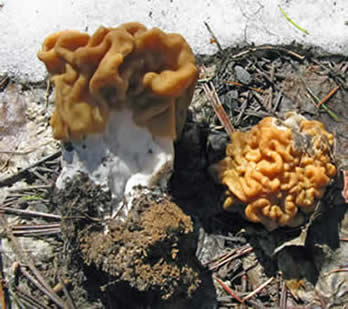
Figure 9: Snow mushroom. (Gyromitra montana).
Photo by Michael Beug
In October of 2008, Dr. Joe Ammirati asked me to see if I could find any species of Cortinarius associated with Oregon White Oak. I checked the literature but found none reported. However, in the following month I found 10 to 20 new species under the Oregon White Oak of the Columbia River Gorge. I found only one species that had previously been named and it was only reported from California. One Cortinarius I found was beautiful mustard yellow, another had gorgeous lilac tones, one had a spectacular fluorescence under UV light and the one turned a striking bright pink when treated with potassium hydroxide. These were all big beautiful mushrooms with striking features. How had they gone undiscovered for so long? How many more new species are under the oaks of Southwestern British Columbia? For that matter, how many new species lurk undiscovered in all of British Columbia – I will bet that there are still several thousand. beautiful and interesting fungi waiting somewhere to be discovered and then studied and named. It is an exciting field open to anyone with an enquiring mind. I myself started off as a toadstool kicker, generally oblivious to mushrooms. A friend gave me some morels that led first to a memorable meal and then to a lifetime of discovery.
Pacific Northwest Key Council
South Vancouver Island Mycological Society
BC
Mushrooms
NTFP
(Non-Timber Forest Products) Mushroom Page
Matchmaker: Mushrooms of the Pacific Northwest
Forest
Pathology Herbarium (Pacific Forestry Centre)
Macrofungi
of British Columbia: Requirements for Inventory
Vancouver
Mycological Society
Canadian
Biodiversity web site: Fungi (contains maps for listed
species)
The
Fungi of California
Cal
Flora-Fungi
Northern
Ireland Fungus Group
Forest
Fungi of New Zealand
Systematics
of the Fungi
Mycotaxon
Mycology
On-line (medical mycology)
The
Mycology.Net
Myconet
Introduction
to the Fungi
Fungi
Images on the Net
Lower
Fungi
Photomicrographs--Fungi
Forest
Pathology--Fungi
Ascomycota: Tree of Life Project
Freshwater
Ascomycete Database
Identifying
Morels and False Morels
Home
of the Xylariaceae
Truffle.org
The
Mycological Society of America
Developing
an online database of descriptions of ectomycorrhizae
MushroomObsever.org
MushroomExpert.com
Recommended citation: Author, date, page title. In: Klinkenberg, Brian. (Editor) 2023. E-Flora BC: Electronic Atlas of the Flora of British Columbia [eflora.bc.ca]. Lab for Advanced Spatial Analysis, Department of Geography, University of British Columbia, Vancouver. [Date Accessed]
E-Flora BC: An initiative of the Spatial Data Lab, Department of Geography UBC, and the UBC Herbarium.
© Copyright 2023 E-Flora BC.